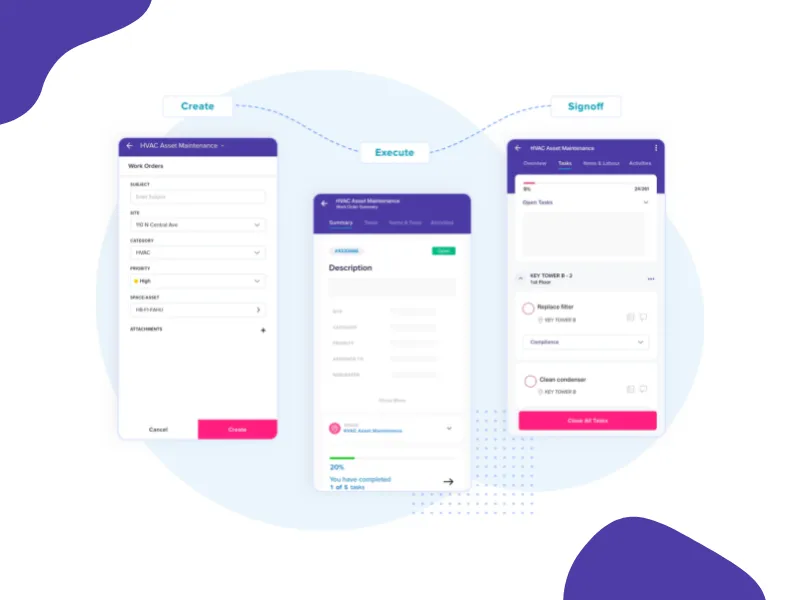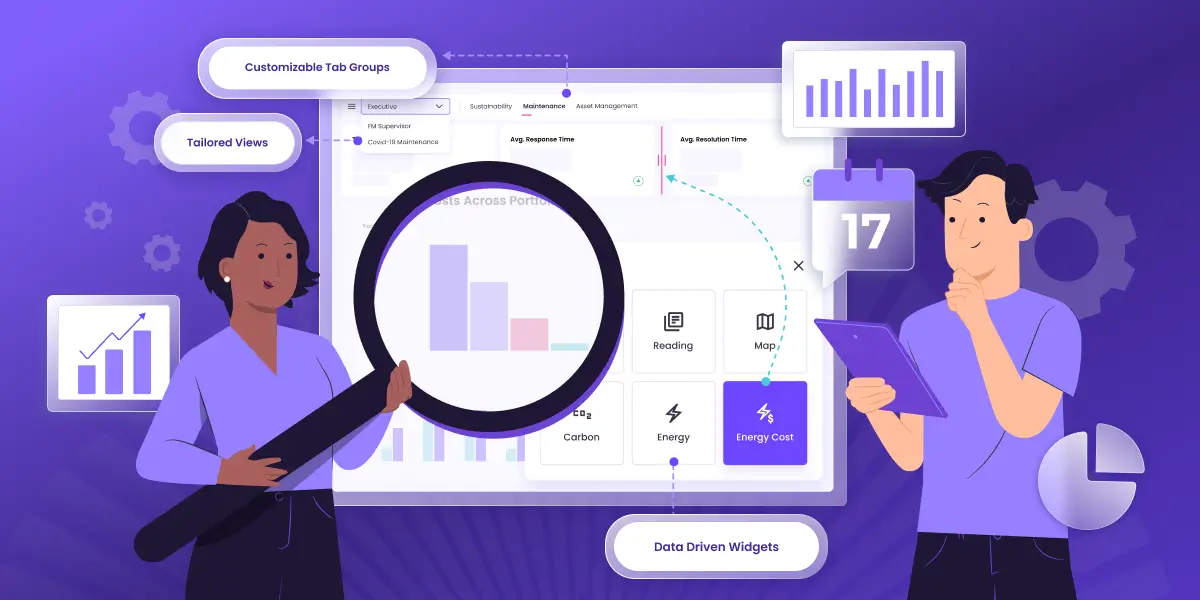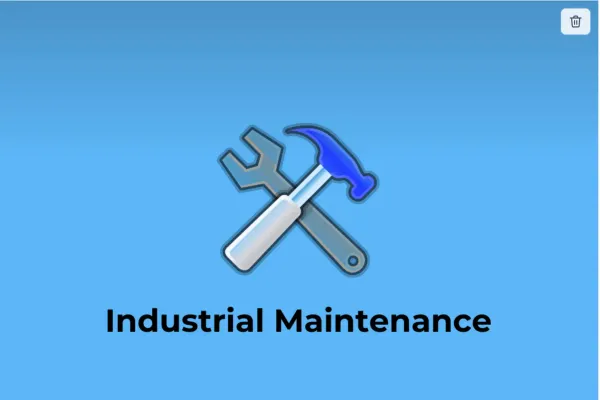What is industrial maintenance?
Industrial maintenance is the upkeep and repair of equipment and machines.
It includes tasks like:
- Equipment maintenance
- Inspection, and
- Repairs
This process aims to keep the machinery running efficiently and safely and prevents downtimes.
Plus, it saves you time and money.

Benefits of industrial maintenance
Industrial maintenance done right can make your business run like clockwork.
Proper industrial maintenance can bring many benefits to a company, including increased equipment uptime and availability, reduced breakdowns or repairs, and improved efficiency and performance, resulting in energy savings and cost savings.
Here are the three main benefits of industrial maintenance:
- Improved safety — You can identify potential hazards and address them in time. For example, an inspection might uncover a loose bolt on a machinery. If left unchecked, this could cause the machinery to malfunction and injure someone.
- Increased efficiency — Machinery production decreases with time as the components wear down. A few precautions go a long way in ensuring your machine keeps running well.
- Extended equipment life —Imagine a tiny crack in a wall. It might seem inconsequential initially, but it could eventually lead to the wall’s downfall. You could have avoided the issue by addressing the tiny crack. The same happens with your machinery. If your routine inspection finds a minor issue, you can correct it with little cost.
What is industrial mechanical maintenance?
Industrial mechanical maintenance refers to the routine maintenance and repair of mechanical equipment and machinery used in industrial settings.
This includes large industrial machines such as conveyor belts and cranes and small equipment such as pumps and motors.
The main goal of industrial mechanical maintenance is to keep the asset in good working condition, prevent breakdowns and extend its life.
Industrial mechanical maintenance involves tasks such as:
- Equipment inspection for wear and tear
- Moving parts lubrication
- Replacing worn parts
- Aligning and adjusting equipment
- Equipment cleaning and maintenance
Preventive maintenance is a crucial aspect of industrial mechanical maintenance.
Maintenance teams schedule routine checkups, replace worn parts before they break, and make adjustments to ensure that equipment continues to run smoothly.
Maintenance teams also perform reactive maintenance, where the teams repair or replace equipment that has broken down unexpectedly.
Properly executed industrial mechanical maintenance helps increase equipment reliability, reduce downtime, and ultimately save money in the long run by extending equipment lifespan and reducing the need for expensive repairs.
IDC study
How CMMS is Evolving Beyond Asset Management & Maintenance. Get your free copy today!
GET THE STUDYDifferent types of industrial maintenance strategies
Each business has different maintenance needs. The best strategies for yours depend on equipment and production requirements.
- Reactive Maintenance
- Preventive maintenance
- Predictive maintenance
- Prescriptive maintenance
- Reliability centered maintenance
1. Reactive maintenance
Also called corrective maintenance, this is an emergency-only approach to maintenance. When something breaks down, the team jumps in to fix it immediately.
This is an effective short-term strategy, but it could be more efficient. In addition, it’s suited for facilities with limited resources that use simple, low-risk equipment.
2. Preventive maintenance
Preventive maintenance is a proactive approach to maintaining equipment and machinery in industrial settings.
It involves regularly scheduled inspections, cleaning, and repairs to prevent equipment failure and improve asset lifecycles.
Preventive maintenance software aims to identify and fix potential problems before they occur, ensuring that the equipment is always running at optimal efficiency.
This type of maintenance is typically performed at regular intervals, such as daily, weekly, monthly, or annually, depending on the specific asset, the equipment maintenance logs and industry.
Examples of preventive maintenance tasks include:
- Inspecting equipment for wear and tear
- Lubricating moving parts
- Replacing worn parts
- Aligning and adjusting equipment
- Cleaning and maintaining equipment, and
- Conducting regular maintenance checks and repairs.
Preventive maintenance can be planned, in which a schedule is set in advance, or unplanned, in which equipment is checked on an as-needed basis. It can be performed by in-house maintenance teams or by outside contractors.
3. Predictive maintenance
Predictive maintenance is a proactive approach to maintaining equipment and machinery in industrial settings.
It uses data and technology to predict when equipment is likely to fail so that maintenance can be scheduled in advance and repairs can be made before the equipment breaks down. This allows maintenance teams to be proactive instead of waiting for equipment to fail before taking action.

Predictive maintenance can be used in various industries, including manufacturing, transportation, and energy. This approach increases equipment uptime, reduces maintenance costs, and improves overall performance.
4. Prescriptive maintenance
Prescriptive maintenance is a highly advanced approach to maintaining equipment and systems in industrial settings.
It uses cutting-edge analytics and artificial intelligence to analyze data from various sources and predict future failures, providing actionable insights on how to prevent them.
This goes beyond predictive maintenance by identifying when a loss is likely and delivering a course of action to avoid it.
Prescriptive maintenance aims to improve equipment reliability and availability, reduce downtime, and optimize maintenance costs.
It can be applied to various industries and equipment, from manufacturing and transportation to energy and healthcare. This is also integrated with other maintenance strategies, such as preventive and predictive maintenance, to provide an even more comprehensive approach to maintenance.
5. Reliability-centered maintenance
Reliability-centered maintenance (RCM) is a method that focuses on ensuring that the most critical equipment and systems in an organization are reliable and available when needed. It prioritizes maintenance activities based on the importance of the equipment to the overall operation to minimize maintenance costs.
The process of RCM starts by analyzing all the equipment and systems in an organization. This analysis is used to identify the functions the equipment intends to perform and the failure modes that could cause the equipment to fail.
This process includes steps such as defining the functions of the equipment, identifying the failure modes, determining the failure modes' causes, identifying the failure modes' consequences, and determining the appropriate maintenance strategy.
RCM is used in various industries, including manufacturing, transportation, and energy. It can also integrate with other preventive and predictive maintenance strategies to provide a more comprehensive approach to maintenance.
Examples of industrial maintenance by industry
We mentioned that different companies need different maintenance strategies. Here are a few examples to better illustrate this point:
- Aviation: The aviation industry is heavily regulated and must adhere to strict safety standards. This makes reliability-centered maintenance (RCM) a good choice for these companies. RCM monitors critical components, such as engines and landing gear. Using sensors to collect data and analyze it in real time, aircraft operators can identify potential problems early on and take appropriate action to prevent failure or mitigate risks. Ultimately, this helps reduce maintenance costs while ensuring their aircraft's and passengers' safety.
- Pharmaceuticals: Pharmaceuticals need a high degree of precision. Quality control is imperative for medicines. These requirements make prescriptive maintenance the ideal system for this type of company. Prescriptive maintenance allows pharmaceutical companies to optimize performance and production.
- Food processing: This industry relies heavily on sensors and data analysis. Food manufacturers often use prescriptive maintenance to monitor food quality and ensure adherence to government standards. This is necessary, as the FDA is known for being especially strict regarding food safety.
Each strategy depends on a certain level of technology. And on having the right people on board to put them in place.
Get in touch
And learn how our solution can help you integrate disparate solutions across portfolios.
SEE A DEMOThe technological revolution in industrial maintenance management
Recent technological advances have enabled the development of new tools for industrial maintenance management.
An example is Condition-Based Monitoring (CBM). CBM uses sensors to measure temperature, pressure, vibration, and stress. This data is then fed into big data analytics tools. These use machine learning algorithms to identify patterns and predict issues or breakdowns.
Digital twinning is another emerging technology in industrial maintenance management. A digital twin is a replica of a physical system. So instead of making changes to your system, you create a digital model of it.
And then test out various scenarios in this replica to see how they play out. Drones are also excellent helpers for various maintenance tasks. For example, let's say you have a plant with a pipeline network spread over a large area. You could use drones to fly overhead and inspect your pipes.
Drones also monitor critical infrastructure like power grids. They are your work crews' best ally in keeping safe when performing maintenance tasks in hard-to-reach places. Outside the industry, drones are used for farm monitoring and pesticide spraying to minimize wasted pesticides and improve crop growth.
Is your business running on old machinery? Don't give up just yet.
Other breakthrough technologies in industrial maintenance management include the Internet of Things (IoT), big data, and predictive analytics.
And finally, the Internet of things (IoT) is a critical enabling technology for digital transformation in industrial maintenance management.
IoT is the network of physical objects connected to the Internet that can communicate with each other.
By combining "smart" sensors and devices with your plants and machinery, you can get real-time data about their performance and health, which you can use to make decisions about maintenance and repairs.
Big data refers to the massive amounts of structured and unstructured data that we now have access to due to technological advances. Companies can use big data analytics tools to mine this data for valuable insights and patterns to improve business processes and results.
Predictive analytics rely on machine learning algorithms and predictive models to analyze historical data to predict future outcomes.
For example, a predictive model may use past failures of an industrial asset like a pump or compressor to expect when it will fail again.
Industrial maintenance trends
Here are a few industrial maintenance trends:
- Increased use of data and analytics: Organizations seek more profound insights into their equipment and systems. This means they can identify potential problems and make more informed decisions about maintenance activities.
- Increased adoption of IoT and connected devices: Companies gather more data about their equipment and systems, using it to improve maintenance processes.
- More prominent use of AI and machine learning: Businesses are looking to automate maintenance processes and gain insights from large amounts of data. As a result, the use of AI and ML is expected to grow.
- More focus on predictive and prescriptive maintenance: Predictive and prescriptive maintenance is expected to become increasingly popular as a more proactive approach in maintenance activities rather than reactive.
- Greater emphasis on sustainability and environmental responsibility: Industrial maintenance is expected to emphasize sustainability and ecological responsibility as organizations look to reduce their environmental impact and meet regulations.
- Greater use of mobile and cloud-based technologies: Mobile and cloud-based technologies will play a more significant part in industrial maintenance as institutions look to improve communication, collaboration, and access to data across their operations.
- Greater emphasis on safety and security: Organizations would focus on safety and security in industrial maintenance to protect their employees, equipment, and data from potential hazards and cyber threats.
Leverage the power of Facilio's Connected CMMS for your industrial maintenance needs
A computerized maintenance management system (CMMS) is essential for any organization looking to implement and scale industrial maintenance.
With a modern CMMS, you'll connect everything in your organization — from the machinery to your people and resources — allowing you to make better maintenance, repairs, and upgrade decisions.
With Facilio's Connected CMMS solution, you can have an active partner in your industrial maintenance efforts.
It provides you with data-driven insights and recommendations that can help you improve the performance of your machinery. Our platform has the right tools and features to optimize preventive maintenance schedules, reduce downtime, or streamline the repair process.
See a demo
Get in touch with us today and learn how to ace industrial maintenance in your organization.


